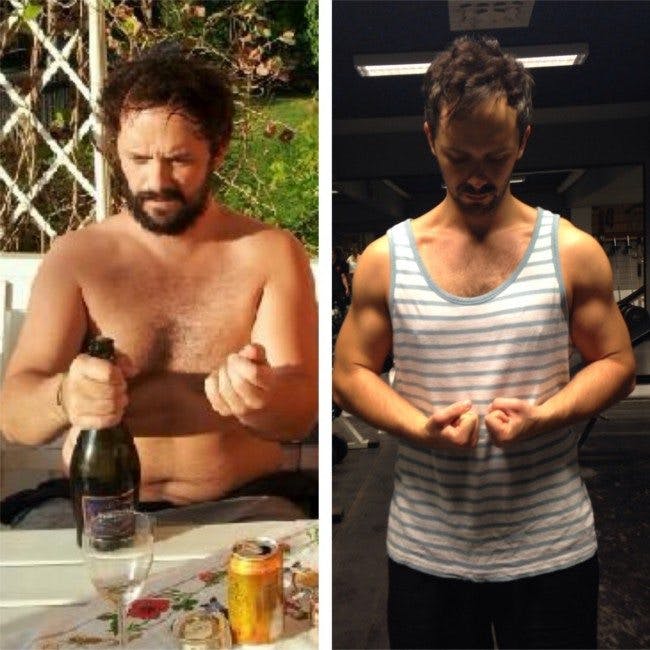Before and after a year with LCHF

Before and after
Here’s yet another complete transformation from eating an LCHF diet. Pär Johansson sent me his story about what a little more than a year on an LCHF diet has done for him:
His E-mail
A weight loss of 55 lbs (25 kg) and still losing. I’ve followed an LCHF diet for a year and a month, and do strength training regularly, but mostly diet and motivation have done it. Let me know if you’re interested in posting on your blog? / Sincerely, Pär
Congrats! Do you want to be featured on the blog with your story and pictures? With or without name?
Sincerely, Andreas
Thank you!
I’d love to be featured on your blog with picture, name and story. After all, it’s thanks to your website that my life turned around and I felt that there was help. When I also read your book The Food Revolution everything changed =), so many thanks and I’m extremely grateful. My whole life has changed!
Here’s my story!
I was overweight as a child, and this has persisted. This is something I’ve always felt very badly about, and it has stayed with me into adulthood. During my teenage years I lost more and more weight. I had constant colds, joint pain, fatigue etc. At age nineteen, after a year of assessment while suffering a generally poorer and poorer general health, doctors found that I’m gluten intolerant. By this time I didn’t feel good at all. All of a sudden I had to adjust to what I should eat and shouldn’t eat. Anyway, I adjusted, but finally the pounds started to pile back on again. And there I was back to being overweight. Food has always been a loaded subject and created anxiety for me. I’ve always fought against prejudices: eat less and move more. In reality, I’ve always had to think about what I eat and have still been overweight.
Finally, a little more than a year ago, despite running all the time and being mindful not to eat too much, smaller portion sizes, following all the conventional dietary guidelines, I was slowly gaining more and more weight. I began to ponder – what’s wrong? It’s not supposed to be like this?! I’m doing all I can, nothing happens..
I started to search online, found the Diet Doctor’s website as I had heard about him through a childhood friend, who advocated this diet. I had previously briefly tried the low-glycemic diet, but didn’t feel that it suited me. At first I just thought this was just one more diet for losing weight, that would fail one more time. But I ended up reading the book the Food Revolution and the Diet Doctor blog, and this was my first eye opener. All dietary advice, all that we’ve always heard, is what’s wrong, and this is how I should eat. My body responded miraculously fast with better mood, weight loss and the most important thing for me: No more agony, no more worries about not being able to enjoy eating without thinking about every pound, no more loaded subject. Sure, I was going to skip sugar and carbohydrates, but the diet was naturally gluten free and the results outweighed needing to stuff myself with pasta, or sugar in general, before exercise. With the results I got, I took one week at a time. Now, a year later, I’m the same size as I was when I was thin from malnutrition due to the gluten intolerance. The difference is that today I have a healthy body, that is only getting healthier and healthier. Finally, I can exercise without thinking it’s because of my weight, but for my health, and enjoy eating a diet that makes feel good. Really good.
A final word. The only fear that comes with this diet is that people still think it’s totally OK to drink coke and eat a lot of sugar, but frowns upon me eating real butter and cream.
Thank you, Diet Doctor!
Sincerely, Pär
More
Share your story
Do you have a success story you want to share? Send your information, plus before and after photos, to success@dietdoctor.com. It would also be greatly appreciated if you shared what you eat in a typical day, whether you fast etc. More information:
Share your story!